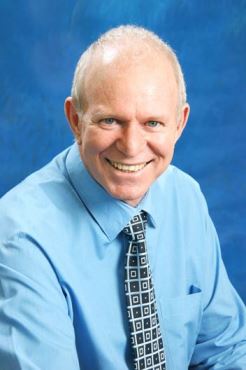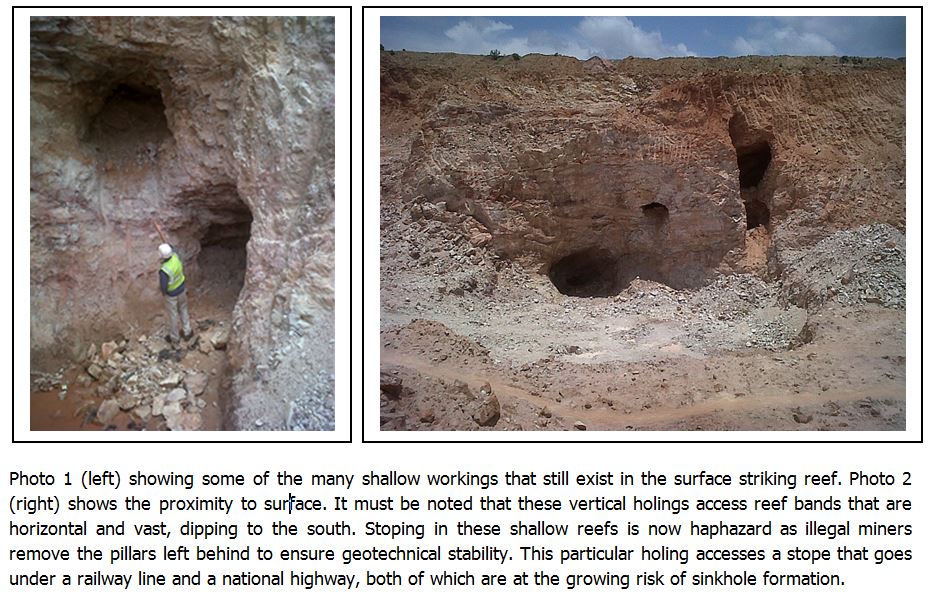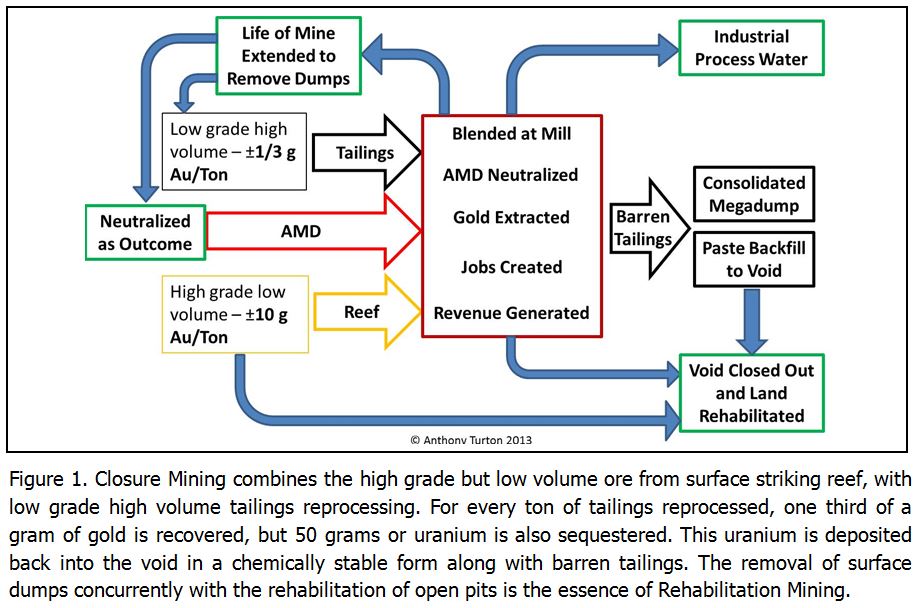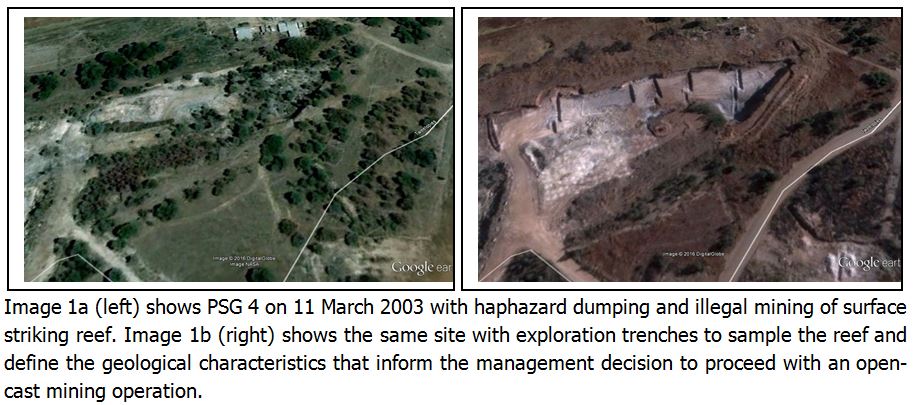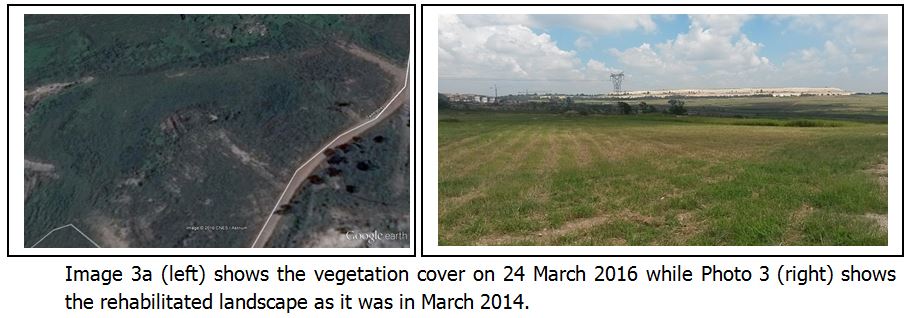South Africa is a mature mining economy, once the largest producer of gold in the world (Hart, 2013). The majority of the gold-bearing ore body is found in a complex reef package that generally strikes to surface on an east-west plane. There are four hydrologically defined mining basins in the Witwatersrand Goldfields – Eastern, Central, Western and Far Western.
The only deep level mining still taking place is in the Far Western Basin. In all other basins the escalating cost of labour and energy has distressed the mining companies and dewatering has become prohibitive (Turton, 2015a). This has flooded the other three basins with decant to surface of highly acidic mine water, occurring in 2002 at 18 Winze Shaft on the Tweelopies Spruit, close to the continental watershed divide that separates the Limpopo and Orange River Basins.
The highly acidic decant has left a complex uranium plume (Coetzee et al., 2006), including the sediment of the Tweelopies Spruit, one of the many tributaries of the Limpopo River. A larger plume of uranium is found on the opposite side of the watershed divide, migrating down the Wonderfontein Spruit, a tributary of the Mooi that flows into the Vaal and ultimately the Orange River (Wade et al., 2002; Winde, 2010), posing a risk to the Zuurbekom karstic well-field that provides some of the water to the city of Johannesburg (Hartnady et al., 2012).
The Stark Reality of the Legacy of Apartheid in the Mining Sector
The gold mining industry is now deeply distressed, with disinvestment taking place as capital migrates out of the country. This has left behind large swathes of land that are mining-impacted but also unrehabilitated. The legacy of Apartheid is such that insufficient money was set aside to fund rehabilitation post-closure, so the country faces a stark reality as the natural dynamics of disinvestment drive marginal companies into insolvency. There are three main consequences of this (Turton, 2015b) if left unmanaged:
- Large quantities of gold bearing reef are still in place in the form of pillars protecting shaft collars, railway lines, highways and buildings on surface. These are being attacked by illegal miners working in armed criminal gangs. This active mining is creating geotechnical instability on surface, with sufficient ore to fund illegal operations for a century into the future.
- The surface striking reef extends through the city of Johannesburg from the town of Springs in the east to the town of Randfontein in the west, a distance of over 100 km. Each of these reef bands typically has a holing to surface every 100 metres apart as part of the mining that occurred a century ago. These holings give easy access to the reef, a fact that is exploited by the illegal miners (see Photo 1 & 2).
- The generation of acid mine drainage (AMD) from the three flooded mining basins is 136 Ml/d at steady state, with peak flows of 229 Ml/d. The pH is typically between 2 and 4, with uranium as a factor in the Western Basin (Winde, 2010) decant given the co-existence of gold and other heavy metals in that specific reef package.
The fundamental problem is that the regulatory framework under Apartheid did not make adequate provision for post-closure rehabilitation. There is now insufficient resource left to retroactively fund rehabilitation. The pivotal question is thus how to attract capital back into Brownfield sites in such a way that rehabilitation can be funded in the absence of adequate financial resources that should have been set aside over more than a century of mining. The response to this is an experimental process known as Rehabilitation Mining, also referred to as Closure Mining.
The logic being that rehabilitation generates a quantifiable benefit accruing to society, so this can be brought onto balance sheet and used to offset century-old environmental liabilities that would render the company insolvent if not dealt with in this manner.
More importantly, if uranium can systematically be removed from source, then the cumulative benefit arising from the reduced movement of pollution plumes can also be calculated and used as a multiplier to make a viable investment case for Brownfield sites with massive environmental liabilities. This is done by concurrently reprocessing surface tailings that contain both uranium and gold along with hard rock found in surface striking reef (see Figure 1).
Closure Mining as a Regulatory Mechanism for Brownfield Site Rehabilitation
An example of this is found in the rehabilitation of a surface striking reef adjacent to 18 Winze Shaft (the only active AMD decant point). This was done by means of an open-cast operation known as PSG 4, which removed all surface striking reef to a depth of about 40 metres. The pit was backfilled with waste rock and covered with top soil as shown in the sequence of Google Earth images below.
Lessons Learned
There have been many lessons learned from this rehabilitation process. The most significant being that rehabilitation of mine impacted landscapes can be incentivised by offsetting the historic liability held on the books of the company against the value of the land being released for higher economic use post-closure. This is not yet recognized in the South African regulatory environment, but engagement between all stakeholders (including investors and regulators) is encouraging.
The PSG 4 case proves that if regulatory reform can accurately quantify the benefit of rehabilitation, and allow it to be offset against historic liabilities in an open and transparent way, then capital can be attracted back into the Brownfield mining sites of the Witwatersrand Goldfields. This has major implications for the rehabilitation of the uranium pollution (Coetzee, 1995) that will confront the city of Johannesburg if marginal mining companies become insolvent and the environmental liability is effectively nationalised (Turton, 2015b).
It also has significant implications for the stabilization of land, including highways, railway lines and buildings, under which shallow stoping by illegal miners is actively taking place in a haphazard manner. More importantly this has the potential to create jobs in a sector currently shedding jobs by the thousands as major mining companies divest their toxic assets, encumbered by a century of unfinanced environmental liability.
This is a work in progress, so the final outcome cannot be accurately predicted at the time of writing.
References
Coetzee, H. 1995. Radioactivity and the Leakage of Radioactive Waste Associated with Witwatersrand Gold and Uranium Mining. In Merkel, B. J., Hurst S., Löhnert E.P. & Struckmeier W. (Eds.) Proceedings Uranium Mining and Hydrogeology 1995, Freiberg, Germany: GeoCongress 1. – 583 S.; Köln (von Loga; ISBN 3-87361-256-9).
Coetzee, H., Winde, F. & Wade, P.W. 2006. An Assessment of Sources, Pathways, Mechanisms and Risks of Current and Potential Future Pollution of Water and Sediments in Gold-Mining Areas of the Wonderfonteinspruit Catchment. WRC Report No. 1214/1/06. Pretoria: Water Research Commission.
Hart, M.H. 2013. Gold: The Race for the World’s Most Seductive Metal. London: Simon & Schuster.
Hartnady, C., Mlisa, A., Turton, A.R., Blake, D., Goyns, A., Simpson, G., von Scherenberg, L., Khudzai, A., Burgher, K. & Seyler, H. 2012. Research Project to Investigate Acid Water Plumes, Decants and Intersects with Rand Water’s Potable Water Pipelines: Phase 1. Report No. 810-04/01/2012. Johannesburg: Rand Water.
Turton, A.R. 2015(a). Untying the Gordian Knot: Unintended Consequences of Environmental and Water Policy for the Gold Mining Industry in South Africa. In Water International (Special issue on mining).
Turton, A.R. 2015(b). When Gold Mining Ends – an Environmental Catastrophe for Johannesburg? In New South Africa Review (5). Johannesburg: Wits University Press.
Wade, P.W., Woodbourne, S., Morris, W.M., Vos, P. & Jarvis, N.W. 2002. Tier 1 Risk Assessment of Selected Radionuclides in Sediments of the Mooi River Catchment. WRC Project No. K5/1095. Pretoria: Water Research Commission.
Winde, F. 2010. Uranium Pollution of the Wonderfontein Spruit, 1997-2008. Part 2: Uranium in Water – Concentrations, Loads and Associated Risk. In Water SA, Vol.36: No.3; 257-278.
AUTHOR INFO:
 Professor Anthony Turton
Professor Anthony Turton
Centre for Environmental Management
University of Free State
Bloemfontein, South Africa.

